Prism 3 -- Saturation Binding Curves and Scatchard Plots
Step-by-Step Examples:
Radioligand Binding Analysis with Prism 3
Saturation Binding Curves and Scatchard Plots
In this step-by-step example, we'll make a commonly used combination graph—saturation binding curve with an inset Scatchard plot.
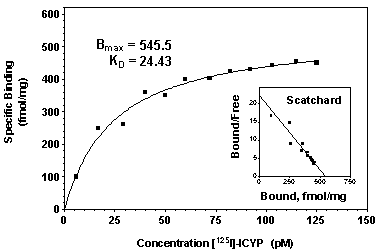
Scatchard analysis is a method of linearizing data from a saturation binding experiment in order to determine binding constants. One creates a "secondary" plot of specific binding/free radioligand concentration (Y axis) vs. specific binding (X axis). For each site where the ligand binds according to mass-action kinetics, the Scatchard plot is a straight line with
Y intercept = Bmax/Kd,
X intercept = Bmax
slope = -1/Kd
Now that programs such as Prism easily do nonlinear regression, the best way to determine Kd and Bmax is to fit a hyperbola directly to the saturation isotherm. Yet Scatchard analysis remains a good way to visualize saturation binding data. We'll show how to combine these techniques, creating a conventional Scatchard plot, but superimposing a line that reflects the best possible estimates of Kd and Bmax.
Create a Table of Specific Binding Data
When you launch Prism, the Welcome to Prism dialog appears. It lets you create a new project (file) or open an existing one. Choose to Create a new project and to Work independently.

The lower portion of the Welcome dialog presents choices for formatting the first data table. For the X column, select Numbers (XY Graph). For the Y columns, choose the format that fits your data; to keep data entry in this example short, we'll use A single column of values. Uncheck the option box at the bottom of the Welcome dialog to Pop up new user hints. When you click OK, Prism displays the new table.
For each point on the saturation binding curve, enter the concentration of ligand into the X column and the value for specific binding into the Y column. The units you use are up to you—use whatever is meaningful. Just remember that Prism will graph the data and compute the binding parameters in whatever units you've used on your table. Place labels over the X and Y columns as a reminder.

Here are the data for our example:

We won't cover it here, but Prism can determine specific binding values for you, starting from total binding and nonspecific binding. For details, consult the chapter in Analyzing Data with GraphPad Prism entitled "Analyzing saturation radioligand binding data", under the heading "Nonspecific binding".
Click on the yellow Graphs tab (tool bar), to view the graph of your data. The illustration below includes some formatting additions that we won't cover here—if you want to learn more about that, consult the Prism User's Guide.
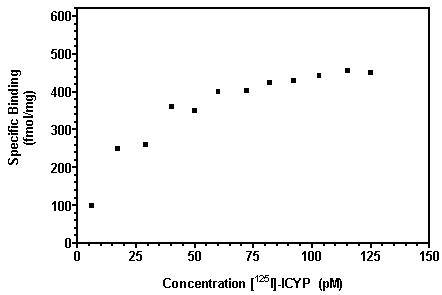
Fit the Saturation Binding Curve to Compute Kd and Bmax
Click on the Analyze button. From the Curves & Regression category, select Nonlinear regression (curve fit). Click OK. In the Parameters: Nonlinear regression dialog box, choose Classic equations. Select One site binding (hyperbola). Click the Output button, and under the Range of X values category, de-select Choose min. X value automatically. For Minimum X=, enter 0. This will cause Prism to extrapolate the binding curve to the origin, rather than starting it at the lowest value of X on your data table. Click OK twice to exit the parameters set-up and complete the curve fit.
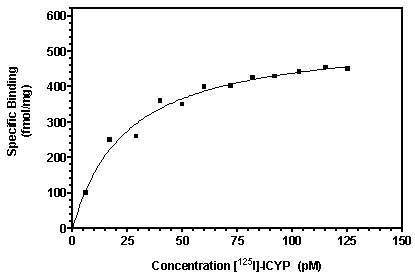
Click the yellow Results tab, or choose the sheet Results-1:Nonlinear regression (curve fit). Prism displays the best-fit values for the binding parameters.

The units for Bmax are the units that you used when entering Y values on the original data table. The units for Kd are the units you used when entering the X values.
Display Binding Constants on the Graph
If you wish, you can paste cells from this results table to your graph, so that your binding constants will be displayed there and will also be linked to the results sheet. That way, if you change the saturation binding data later, Bmax and Kd will be automatically updated both on the results sheet and on the graph. If you don't like the way the pasted data are displayed, you can change that. Suppose that you wish to paste the data, but make your own labels and customize the display. Select a cell on the results sheet containing the value you want to paste. Choose Edit.. Copy. Switch to the graph, and choose Edit.. Paste Table. The value is placed on the graph, and you can drag it wherever you want. Now use the text tool (bottom row of the toolbar)...

...to add customized labels. Click on the text tool button, then click on the graph approximately where you want the label, and type your label. You can make the label boldface, or resize it, or add subscripting as desired, using the text editing tools.

Click elsewhere to exit the text insertion mode, then select the label so that you can drag it into position (use the "arrow" keys on your keyboard to make the final adjustments). Here is a finished example:
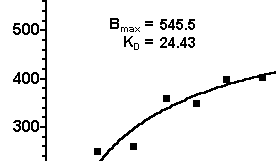
At this point, you may wish to change some of your original saturation binding data (data table) and observe how the values of Bmax and Kd change automatically on the results sheet and on the graph.
Prepare the Scatchard Transforms
We'll start the Scatchard analysis by transforming the saturation binding data. The original data table has the "free" ligand concentration in the X column and the "bound" ligand concentration in the Y column. To get "bound" in the X column and "bound/free" in the Y column, we need to do some transforming. From the original table containing the saturation binding data, click Analyze and select Type: Data manipulations and Transforms. In the next dialog, Parameters: Transformations, choose to interchange X and Y and then to replace Y with X/Y. At the bottom of the dialog, check the box to Create a new graph of the results. Here are the settings for the transforms:
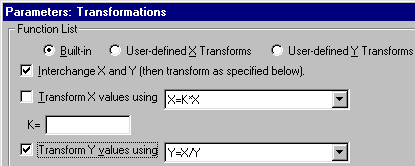
The transformed data are shown on a new results sheet (the original data are unchanged in the "Data tables" section of your project). Prism will carry over the original column titles, which will now be incorrect, so you can edit them:

Complete the Scatchard Plot
The default Scatchard plot appears as the most recently generated graph, which is probably labeled Graph-2:X-Y Plot. You will notice that there is no line superimposed over the points. We recommend that you add a line to your graph that connects the X and Y axis intercepts in such a way as to accurately reflect the Kd and Bmax values that we have just found by nonlinear regression. Referring to the results sheet for your nonlinear regression analysis, compute the Y coordinate for the Y axis intercept manually a
Bmax/Kd = 545.5/24.43 = 22.33
Switch to the table section of your project, choose New Table, and format the table for X = Numbers (XY Graph) and Y = A single column of values. Fill in the table using the values for Bmax and Bmax/Kd as follows:
- Into row 1 enter X = 0, Y = Bmax/Kd
- Into row 2 enter X = Bmax, Y = 0
Here's the table:
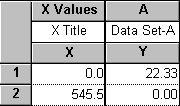
Note the name of this data table. You may wish to rename it to something more meaningful, such as "Scatchard Line Data". Now switch to the Scatchard plot, i.e., the graph we created in the previous section (if your sheet titles match those in this example, the Scatchard plot is Graph-2). Choose Change.. Data on Graph and add the new data table to the graph (click Add..., then select the correct data set from the list in the next dialog box.

Click Add again, then Close to return to the previous dialog, then OK to complete the process.
This results in the Y and X intercepts being plotted as points. Format this data set to make the points invisible but to connect them with a line: Press Change.. Symbols and Lines. On the list of data sets, select the one you noted above (e.g., Scatchard Line Data. Choose to plot no symbols, but to connect them with a line.

Here is the Scatchard plot, with a few a formatting changes that we haven't covered here:

Create a Layout Showing the Saturation Isotherm, with Inset Scatchard Plot
Switch to the Layout section of your project, and click New Layout. Choose the Landscape orientation and the Inset arrangement:
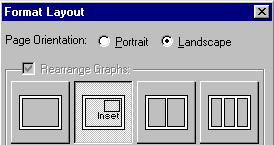
When you click OK, you'll see a layout with two placeholders. Double-click on each in turn, assigning your saturation binding plot to the larger, and your Scatchard plot to the smaller, placeholder. Then move and resize the Scatchard plot:
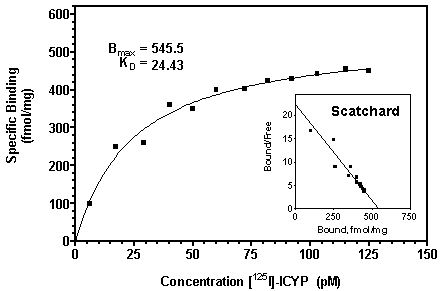
Important note: If, after viewing your layout, you want to resize individual objects/labels to enhance readability, switch back to the appropriate graph sheet and make the changes there. Test the changes by switching back to the layout, which updates automatically. One exception to this is when you want to change the size of the overall layout or change the sizes of the two graphs on the layout relative to one another. Do that directly on the layout, by selecting the inset graph, or the entire layout, and then dragging as appropriate.















